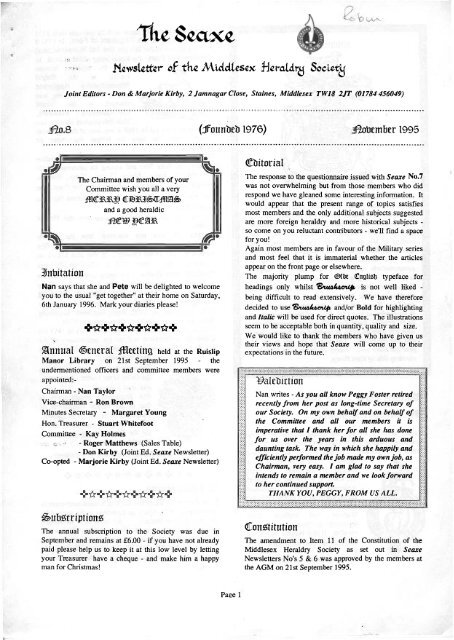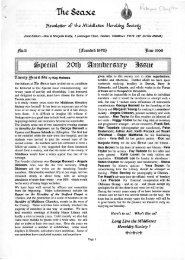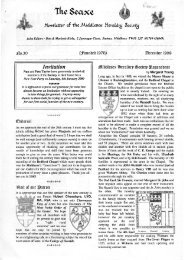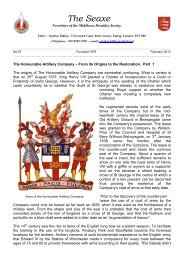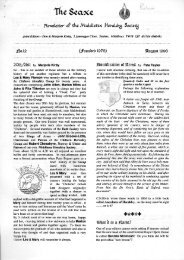The Seaxe - Middlesex Heraldry Society
The Seaxe - Middlesex Heraldry Society
The Seaxe - Middlesex Heraldry Society
You also want an ePaper? Increase the reach of your titles
YUMPU automatically turns print PDFs into web optimized ePapers that Google loves.
<strong>The</strong> Chairman and members of your<br />
Committee wish you all a very<br />
MERRY CHRISTMAS<br />
and a good heraldic<br />
NEW YEAR<br />
<strong>The</strong> <strong>Seaxe</strong><br />
Newsletter of the <strong>Middlesex</strong> <strong>Heraldry</strong> <strong>Society</strong><br />
Joint Editors - Don & Marjorie Kirby, 2 Jamnagar Close, Staines, <strong>Middlesex</strong> TW18 2JT (01784 456049)<br />
No.8 (Founded 1976) November 1995<br />
Invitation<br />
Nan says that she and Pete will be delighted to welcome<br />
you to the usual "get together" at their home on Saturday,<br />
6th January 1996. Mark your diaries please!<br />
Annual General Meeting held at the Ruislip<br />
Manor Library on 21st September 1995 - the<br />
undermentioned officers and committee members were<br />
appointed:-<br />
Chairman - Nan Taylor<br />
Vice-chairman - Ron Brown<br />
Minutes Secretary - Margaret Young<br />
Hon. Treasurer - Stuart Whitefoot<br />
Committee - Kay Holmes<br />
- Roger Matthews (Sales Table)<br />
- Don Kirby (Joint Ed. <strong>Seaxe</strong> Newsletter)<br />
Co-opted - Marjorie Kirby (Joint Ed. <strong>Seaxe</strong> Newsletter)<br />
Subscriptions<br />
<strong>The</strong> annual subscription to the <strong>Society</strong> was due in<br />
September and remains at £6.00 - if you have not already<br />
paid please help us to keep it at this low level by letting<br />
your Treasurer have a cheque - and make him a happy<br />
man for Christmas!<br />
Page 1<br />
Editorial<br />
<strong>The</strong> response to the questionnaire issued with <strong>Seaxe</strong> No.7<br />
was not overwhelming but from those members who did<br />
respond we have gleaned some interesting information. It<br />
would appear that the present range of topics satisfies<br />
most members and the only additional subjects suggested<br />
are more foreign heraldry and more historical subjects -<br />
so come on you reluctant contributors - we'll find a space<br />
for you!<br />
Again most members are in favour of the Military series<br />
and most feel that it is immaterial whether the articles<br />
appear on the front page or elsewhere.<br />
<strong>The</strong> majority plump for Olde English typeface for<br />
headings only whilst Brushscrip is not well liked -<br />
being difficult to read extensively. We have therefore<br />
decided to use Brushscrip and/or Bold for highlighting<br />
and Italic will be used for direct quotes. <strong>The</strong> illustrations<br />
seem to be acceptable both in quantity, quality and size.<br />
We would like to thank the members who have given us<br />
their views and hope that <strong>Seaxe</strong> will come up to their<br />
expectations in the future.<br />
Valediction<br />
Nan writes - As you all know Peggy Foster retired<br />
recently from her post as long-time Secretary of<br />
our <strong>Society</strong>. On my own behalf and on behalf of<br />
the Committee and all our members it is<br />
imperative that I thank her for all she has done<br />
for us over the years in this arduous and<br />
daunting task. <strong>The</strong> way in which she happily and<br />
efficiently performed the job made my own job, as<br />
Chairman, very easy. I am glad to say that she<br />
intends to remain a member and we look forward<br />
to her continued support.<br />
THANK YOU, PEGGY, FROM US ALL.<br />
Constitution<br />
<strong>The</strong> amendment to Item 11 of the Constitution of the<br />
<strong>Middlesex</strong> <strong>Heraldry</strong> <strong>Society</strong> as set out in <strong>Seaxe</strong><br />
Newsletters No's 5 & 6 was approved by the members at<br />
the AGM on 21st September 1995.
Obituary<br />
It is with sadness that we have learned of the death<br />
of Henry Alan Walter Richmond Percy, 11th Duke<br />
of Northumberland at the very young age of 42.<br />
He was our "local" duke and one of a "dynamic<br />
dynasty" which included a baron present at the<br />
sealing of Magna Carta. He was a godson of the<br />
Queen by virtue of the close friendship of his father<br />
with the Royal Family. <strong>The</strong> Duke lived a<br />
comparatively quiet life but as the largest<br />
landowner in England, devoted most of his time to<br />
the administration of the 80,000 acre Percy estates<br />
together with the maintenance of Alnwick Castle<br />
and Syon House. Henry Percy was a bachelor and<br />
is succeeded as the 12th Duke of Northumberland<br />
by his brother, Lord Ralph George Algernon Percy,<br />
who was born in 1956, is married and has two sons<br />
and two daughters. <strong>The</strong> heir to the title is the 11<br />
year old elder son, George Dominic, who takes the<br />
courtesy title of Earl Percy.<br />
Militaria No.6 - <strong>The</strong> Royal<br />
Warwickshire Regiment<br />
Raised in 1674 through the amalgamation of several<br />
companies fighting for William of Orange as (Sir Walter)<br />
Vane's Regiment. It was known as a Holland<br />
regiment - for about eighty years,<br />
starting in the reign of Queen<br />
Elizabeth I, a number of English<br />
regiments were employed<br />
continuously in the Netherlands but<br />
when war broke out between<br />
England and Holland those<br />
regiments in Dutch service were<br />
recalled. It first became part of the<br />
establishment of the English army<br />
in 1688 as Colonel<br />
Babbington's Regiment of<br />
Page 2<br />
Foot and changed its name with its colonels until 1751<br />
when it became the 6th Regiment Of Foot. In 1782 it<br />
became known as the 6th (or the 1st Warwickshire)<br />
Regiment Of Foot - the Royal being added in 1832. In<br />
1881 the regiment became<br />
known as the Royal<br />
Warwickshire Regiment<br />
and in 1963 its name was<br />
changed to the Royal<br />
Warwickshire Fusiliers.<br />
This independent identity was<br />
to be short lived for in 1968 it was one of the regiments<br />
which merged to form the Royal Regiment Of<br />
Fusiliers<br />
<strong>The</strong> regiment took part in the Crimean War, the Indian<br />
Mutiny, the Boer War and among its numerous battle<br />
honours are Mons, Marne, Ypres, Vimy, Somme,<br />
Passchendaele, Arras and Gallipoli from the Great War<br />
and the Normandy Landing, Caen and Burma from the<br />
second World War.<br />
Six members of the regiment have won the Victoria<br />
Cross.<br />
As the 6th was not absorbed into the British<br />
establishment until 1688 it thereby acquired its first<br />
nickname "<strong>The</strong> Dutch Guards". It was also known as<br />
"Guise's Geese" - from 1738 to 1765 the CO was<br />
Colonel John Guise - a dashing soldier whose men<br />
would follow him blindly. <strong>The</strong> last Colonel of the<br />
Regiment was "Monty", Field-Marshal Viscount<br />
Montgomery of Alamein who joined the regiment<br />
from Sandhurst in 1908. Field-Marshal Viscount<br />
Slim was commissioned into the regiment in 1914.<br />
After the Battle of Echalar (Peninsular War) in 1813 the<br />
Duke Of Wellington said, of the performance of the<br />
6th, It was the most gallant and finest thing I have<br />
ever witnessed.<br />
<strong>The</strong> regimental motto is the same as<br />
the Order of the Garter - honi soit<br />
qui mal y pense.<br />
<strong>The</strong> Regimental Headquarters is<br />
that of the Royal Regiment of<br />
Fusiliers at the Tower of London.<br />
<strong>The</strong> recruitment area is as shown<br />
for the Royal Northumberland<br />
Fusiliers (<strong>Seaxe</strong> No.7) who are<br />
now also part of the Royal Regiment of Fusiliers.<br />
Red Hatchments<br />
Pete Taylor mentions that the Tradescant hatchment in<br />
the Church of St Mary at Lambeth is the second he<br />
has come across recently - the other is in Breamore<br />
Church, Hampshire to the Hulse family. He wonders<br />
why a red background - but why not - who said it<br />
had to be black? Did the local artist/handyman<br />
belong to the Communist party - or had he run out<br />
of black paint?
Life of Attlee<br />
Kenneth Harris in his recently published biography of<br />
Clement Attlee writes that what he liked and<br />
admired about him was<br />
his seriousness about life<br />
but also his complete<br />
unseriousness about<br />
himself. He was always<br />
conscious of how his own<br />
perceived shortcomings<br />
might cause problems for<br />
other people. And his<br />
sense of values was<br />
egregious. He told me in<br />
Arms: Azure on a chevron Or between three<br />
hearts of the last winged Argent as many<br />
lions rampant Sable<br />
(<strong>The</strong> winged hearts are from the arms of<br />
Haileybury College.)<br />
his eightieth year that<br />
being prime minister had<br />
been "second best"; if he<br />
had got a first at Oxford<br />
he would have become a don. He was more<br />
amused than impressed by becoming prime<br />
minister, hence this famous limerick. I discovered<br />
it in a letter to his beloved elder brother, Tom, in<br />
1956:<br />
Few thought he was even a starter<br />
<strong>The</strong>re were many who thought themselves smarter<br />
But he ended PM<br />
CH and OM<br />
an earl and a knight of the garter!<br />
<strong>The</strong> Right Honourable Clement Richard Attlee,<br />
1st Earl Attlee, (cr. 1955)<br />
Born Putney 3rd January 1883<br />
Died 8th October 1967<br />
PC 1935 - CH 1948 - KG 1956 - OM 1951<br />
Prime Minister 26/07/45 - 25/10/51<br />
Educated - Haileybury Coll. and University Coll., Oxford<br />
Labour MP - Limehouse District of Stepney 1922-50<br />
- Walthamstow West 1950-55<br />
(We are indebted to Pete Taylor for the biographical<br />
details and for the Attlee arms and blazon - Eds.)<br />
British prime Ministers<br />
This seems to be a suitable point at which to mention the<br />
recent production of a book by Dermot Englefield, et<br />
al, with the title above and published by the D. W.<br />
Wilson Company, New York. It is a compilation of<br />
biographical and historical information about British<br />
Prime Ministers from Robert Walpole in 1721 to<br />
John Major. 47 of the 50 Prime Ministers featured<br />
were armigerous and each of their shields of arms has<br />
been drawn by Pete Taylor. <strong>The</strong> book is available from<br />
the <strong>Heraldry</strong> <strong>Society</strong> at £45.<br />
Page 3<br />
Walpole Again<br />
By a strange coincidence one of your Editors is reading a<br />
book loaned to her by Vera Brown and entitled<br />
Reminiscences of Lady Dorothy Nevill -<br />
who was, of course, born a Walpole. In it she writes -<br />
Chancing on my recent visit to<br />
enter the vestry, [at Ilsington in<br />
Dorset] I found, covered with<br />
dust and rubbish, the<br />
hatchment of George, Earl of<br />
Orford, my eccentric ancestor.<br />
Walpole On mentioning my discovery<br />
to the Vicar, an exceedingly courteous<br />
gentlemen, he most kindly assured me that if<br />
the assent of the Bishop of the diocese were<br />
obtained, I might have it. In due course I<br />
contrived to waylay the said Bishop and obtain<br />
his consent. Before giving it, however, he<br />
inquired whether I was certain the villagers<br />
would not miss it; but I assured him that we<br />
had all been forgotten long ago, and so now<br />
the hatchment hangs in its proper place in the<br />
Norfolk church where we have all been<br />
married and buried.<br />
On referring to Summers we find<br />
that in Houghton Church there are no<br />
fewer than ten hatchments - four to the<br />
Walpole family and the other six to<br />
Bertie. Nos.2,3 & 4 are exactly<br />
similar and a note in parenthesis states<br />
<strong>The</strong>re is an identical hatchment<br />
Bertie<br />
in the parish church at<br />
Wickmere. At Wickmere there are four hatchments -<br />
all to Walpole.<br />
Arms are:- Or on a fess between two chevrons Sable<br />
three crosses crosslet of the first (Walpole)<br />
Argent three battering rams barways in pale<br />
proper headed and garnished Azure (Bertie)<br />
Women and Arms<br />
In the September issue of <strong>The</strong> <strong>Heraldry</strong> Gazette<br />
we read that <strong>The</strong> English Kings of Arms have<br />
decreed that married women who until now have<br />
had to adopt the Armorial status of their<br />
husbands, can now bear their maiden arms on a<br />
shield or banner differenced by a small escutcheon<br />
of a suitable tincture.
Visit to Oxburgh<br />
Margaret Young.<br />
Bedingfeld<br />
on 8th July, 1995 - from<br />
On Saturday, 8th July, we visited<br />
Oxburgh Hall in Norfolk, the<br />
home of the Bedingfeld family<br />
for 500 years. <strong>The</strong> first thing we<br />
saw was a very beautiful French<br />
knot garden, constructed for the<br />
6th Baronet and his wife,<br />
Margaret Paston, in the 1840s.<br />
<strong>The</strong> flowers were yellow, blue and<br />
red, which are the colours in the<br />
arms of the<br />
Paston-Bedingfeld family.<br />
Our first stop was the Chapel<br />
which contained a great deal of<br />
heraldry. It was built by Pugin in<br />
1836 consequent upon the passing<br />
of the Catholic Emancipation Act<br />
in 1829. <strong>The</strong>re is a very fine<br />
heraldic window by Thomas<br />
Willement. In the top of the Paston<br />
centre light are the arms of Edward IV who was<br />
supported in the Wars of the Roses by the Bedingfelds.<br />
<strong>The</strong> Royal shield of fleurs de lys and lions is supported by<br />
two white lions which were<br />
used by King Edward when<br />
he was Earl of March. Below<br />
is his falcon and fetterlock<br />
badge on a standard supported<br />
by a red eagle. In the base of<br />
the window, between the badge<br />
and the eagle, are two<br />
Bedingfeld shields, firstly<br />
Bedingfeld impaling<br />
Edward IV Jerningham and Stafford<br />
quarterly - the second with Paston in pretence. On<br />
either side are the shields of Hemenhall and<br />
Tuddenham, the latter being<br />
the original owner of Oxburgh.<br />
<strong>The</strong> side windows contain<br />
shields of Tuddenham<br />
marriages and include such<br />
names as Beauchamp,<br />
Grandison and Tregose.<br />
On leaving the Chapel we were<br />
Tuddenham<br />
taken on a tour of the Hall itself<br />
which is surrounded by a moat on which lived a family<br />
of swans. A ha-ha separates the<br />
Hall from extensive fields grazed<br />
by a large herd of cows. <strong>The</strong><br />
present house was built cl482 by<br />
Sir Edmund, the first<br />
Grandison<br />
Bedingfeld to live at Oxburgh.<br />
It is built of red brick and is<br />
classed as a moated, fortified<br />
manor house rather than a castle.<br />
Above the entrance tower flies the<br />
family flag and on two turrets<br />
Page 4<br />
Tregoze<br />
there are wrought iron weather<br />
vanes - one being the Paston<br />
arms with a decorated surround<br />
of fleurs de lys - the other<br />
Bedingfeld with a surround of<br />
National Trust acorns. <strong>The</strong><br />
Trust now own the property<br />
although Henry Paston-<br />
Bedingfeld, who recently<br />
became York Herald, and his<br />
family live there.<br />
Once inside the Hall we passed through rooms all with a<br />
stately dignity and all beautifully decorated. <strong>The</strong>re was<br />
heraldry to be seen everywhere together with many fine<br />
portraits. We moved through the saloon to the drawing<br />
room which had a ceiling crossed by narrow wooden<br />
beams making a chequered pattern. Some of the<br />
"squares were, in fact, hexagonal and were painted with<br />
arms of the family surrounded by by delicate floral<br />
patterns. Other squares were painted with badges such as<br />
the portcullis and fetterlock. <strong>The</strong> blue wallpaper is<br />
patterned with fleurs de lys and roses.<br />
<strong>The</strong> north dining room is very splendid, with a rich<br />
wallpaper of red and gold. <strong>The</strong>re is a lot of elaborate<br />
carving introduced by Henry, the 6th Baronet, and his<br />
wife, Margaret who were responsible for much of the<br />
present interior decoration in the Hall. Lovely carved<br />
wooden panels are all round the room; the dado and<br />
timber beams across the ceiling are also carved and there<br />
is a richly carved fireplace<br />
reaching from floor to ceiling. An<br />
hexagonal table has a carved edge<br />
and the four feet appear to be<br />
carriages drawn by gryphons and<br />
driven by cherubs. <strong>The</strong> tile<br />
surround bears the arms of<br />
Bedingfeld on a standard held<br />
by an eagle on one side and on the<br />
other the arms of Paston held by<br />
a gryphon. Above the fireplace is<br />
the fetterlock badge of<br />
<strong>The</strong> Fetterlock<br />
Bedingfeld.<br />
As we ascended the staircase there were more portraits,<br />
more fine carving and some even more elaborate<br />
wallpaper. In the library there<br />
was another beautiful fireplace<br />
which differed from that in the<br />
dining room by by its more<br />
delicate structure in white with a<br />
finely carved wooden<br />
overmantle. Along the front are<br />
the arms of Boyle,<br />
Jerningham<br />
Jerningham, Stafford,<br />
Bedingfeld, Paston and<br />
Howard whilst the tiles round the fire alternate the<br />
monogram HB with the falcon and fetterlock.<br />
<strong>The</strong> two rooms in the tower are known respectively as the<br />
King's and the Queen's room from the time in 1497 when<br />
Henry VII and his Queen visited Oxburgh accompanied
y his mother, Margaret<br />
Beaufort, Countess of Derby,<br />
the Duke of Buckingham and<br />
other notables. <strong>The</strong> bed in the<br />
King's room has a very beautiful<br />
cover embroidered in a design of<br />
the falcon and fetterlock. <strong>The</strong>re<br />
are roses and portcullis painted on<br />
the ceiling and a spiral staircase<br />
Stafford led to the priest's hole - the<br />
Bedingfelds were strongly Catholic and staunchly<br />
Royalist - a combination which caused the family a great<br />
deal of suffering. <strong>The</strong> ceiling in the Queen's room is of<br />
wooden beams and over the fireplace are the arms of<br />
Paston-Bedingfeld with, on either side, banners<br />
portraying other marriages. One entire wall is covered<br />
by a tapestry of an ancient map of Oxfordshire. <strong>The</strong>re is<br />
also an embroidered panel of a country scene by Mary,<br />
Queen of Scots, showing various animals, birds, frogs,<br />
trees and flowers and above it another, bearing her name<br />
as a cypher on either side of which there is a crown with<br />
a thistle over. <strong>The</strong> chairs in the room have embroidered<br />
seats and backs.<br />
Unfortunately, due to our late arrival, our time ran out<br />
and we were unable to visit the Chantry Chapel but it<br />
was a very enjoyable day and our thanks go to Nan<br />
Taylor for making it possible.<br />
Arms are:-<br />
Ermine an eagle displayed Gules (Bedingfeld)<br />
Argent six fleurs-de-lys Azure three two and<br />
one a chief indented Or (Paston)<br />
Lozengy Argent and Gules (Tuddenham)<br />
Paly of six Argent and Azure on a bend Gules<br />
three eagles displayed Or (Grandison)<br />
Or two bars gemelle and in chief a lion passant<br />
Gules (Tregoze)<br />
Argent three buckles Gules (Jemingham)<br />
Or a chevron Gules (Stafford)<br />
[<strong>The</strong> blazons and most of the shields are taken from that<br />
excellent booklet <strong>Heraldry</strong> at Oxburgh by<br />
Sir Edmund Bedingfeld Bt. to whom and to whose<br />
family we offer our sincere thanks for entertaining us in<br />
their beautiful home. It enabled us to enjoy the lovely<br />
view over the moat from inside the house - turning a<br />
memorable day into something very special - Eds]<br />
<strong>The</strong> Wakefield Mystery Plays<br />
<strong>The</strong> Wakefield Mystery Plays will take place twice<br />
nightly, at 6.30pm and 8.30pm, from Monday,<br />
4th December to Friday, 8th December at Holy Trinity<br />
Church, Sloane Square. Admission is free but there will<br />
be a collection on the way out! Angela has asked us to<br />
say that everybody is welcome.<br />
Page 5<br />
Did You Know?<br />
We all know that the British private soldier is called a<br />
Tommy and on VJ Day we were all reminded by the<br />
actor, Dennis Quilley of Kipling's poem Tommy:-<br />
Oh, it's Tommy this, an' Tommy that, an' "Tommy<br />
go away";<br />
But it's "Thank you, Mister Atkins," when the band<br />
begins to play.<br />
But do you know from where the name Tommy or, more<br />
properly, Thomas Atkins came? According to<br />
Tim Carew in the prologue to his book How <strong>The</strong><br />
Regiments Got <strong>The</strong>ir Nicknames - to find<br />
the origin of the pseudonym we must go back to July<br />
1843 when the Duke of Wellington, now aged 74, was<br />
approached by a young staff officer with a letter for the<br />
personal attention of the Commander-in-Chief stating<br />
that the army authorities were looking for a name to use<br />
on a model sheet of the soldiers' accounts to show where<br />
the men should sign - assuming they could write!<br />
Instead of his usual immediate reply the Duke gazed out<br />
to sea searching a packed memory of all the brave deeds<br />
he had seen performed in war, he was searching his<br />
memory for the man who would best typify the dogged<br />
gallantry of Britain's private soldiers - men who swore<br />
fearful oaths, indulged in drunkenness at every available<br />
opportunity and accepted the lash and enemy fire with<br />
equal fortitude. He remembered the bloody battles in<br />
Spain, Portugal, India and the Low<br />
Countries. In particular he<br />
remembered his first command -<br />
the 33rd Regiment of Foot [now<br />
the Duke of Wellington's<br />
Regiment], and how, after one<br />
particularly bloody battle the<br />
young Arthur Wellesley<br />
watched as the stretcher bearers carried the wounded<br />
away. Now he stood over the right hand man of the<br />
Grenadier Company - a giant of a man, six foot three and<br />
twenty years with the colours. He could neither read nor<br />
write but was the best shot in the regiment. Clearly he<br />
was near death - a sabre slash to the head, a bayonet<br />
wound in his chest and bullets through both lungs - but<br />
when he saw his commanding officer looking down at him<br />
with sadness in his eyes and compassion on his face, he<br />
said It's alright, sir - it's all in a day's work - and died.<br />
Wellington emerged from his reverie and turning to<br />
the staff officer said <strong>The</strong> name is Thomas Atkins.<br />
Next Meetings<br />
On Thursday, 21st December we shall be indulging in<br />
Christmas Festivities and the 1996 programme begins on<br />
Thursday, 18th January when Peggy Foster speaks<br />
to us on Our Lady of Batersey.


